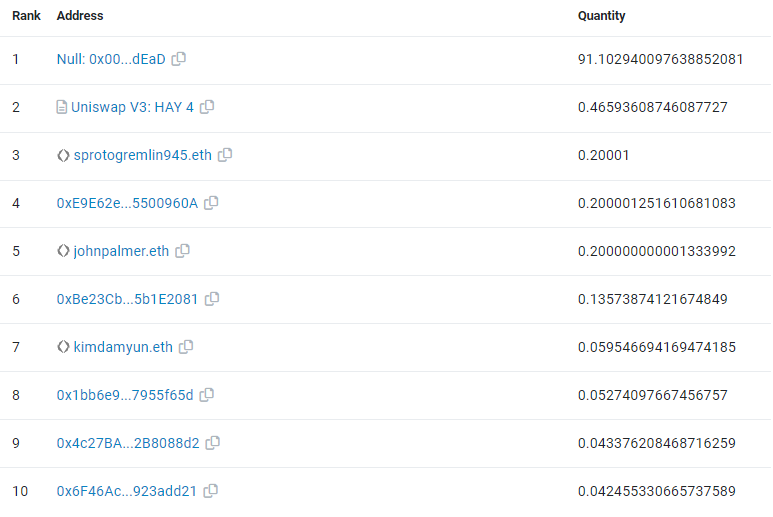Haycoin (HAY) is the first token to be traded on Uniswap. Although it was created in 2018 as a test digital asset with no commercial value, it was recently “revived.”
A few days ago, CriptoNoticias detailed the story of the creation and rediscovery of HAY. Currently, there are those who trade Haycoin and consider it a memecoin.
One of the features of Haycoin that attracts some investors is its scarcity. Due to various token burns, Only 4.2 HAY units were still in circulation. Each of them was worth just over a million dollars at the time of this publication..
In the graphic below, provided by the platform DexToolsthe price of this cryptocurrency has been observed since October 12, 2023:
Since it is only on the market for a few days, There are already “whales”, i.e. large investors, who are starting to take over a large part of the HAY currency..
In the data provided by Ethereum Network Explorer EtherscanIt is found that there are 5,440 HAY holders. Among them are the burning address (destroyed forever at 91.10 HAY) and the Uniswap liquidity pool at 0.47 HAY.
Of the private addresses, “sprotogremlin945.eth” from investor Erik Stevens is the one with the most HAY at 0.20001 HAY. This represents 4.76% of the total circulation of this digital currency. This individual wrote Hours ago he had become the largest HayCoin holder.
Following is an unidentified address with 0.20001 HAY. In fourth place is the address of computer scientist John Palmer (johnpalmer.eth), influencer in the cryptocurrency ecosystem and employee of several projects related to the Ethereum network. Palmer has 0.200000000001 HAY in his wallet.
Just come in These three addresses account for almost 15% of the circulation of the cryptocurrency created by Hayden Adams.
The following screenshot from the browser Etherscan shows the addresses with the most HAY in their possession and the number of tokens of this digital currency that they own.

Liquidity and sell-off risk on Haycoin
The fact that there is so little HAY in circulation is an attraction for many investors. “If something is so scarce, it must be worth a lot,” they think. However, This deficiency also poses significant liquidity risks for current and future Haycoin holders..
The main concern is that with few units available and growing demand, holders may find it difficult to sell their tokens without significantly impacting the market price. This is especially true given this Most HAY is not available in liquidity pools on Uniswapand there are still very few centralized exchanges that offer HAY trading.
If too many buyers want to purchase Haycoin, they could be forced to pay inflated prices due to a lack of sellers. This situation can result in an extremely volatile and unpredictable market, where large orders have the potential to drastically change the price.
Another significant risk is that whales or large Haycoin holders decide to suddenly sell their tokens. Given the concentration of ownership, a sale by one of these whales could result in a sharp price drop. This would not only negatively impact HAY’s market value, but could also trigger a chain effect that causes other holders to panic sell to limit losses, which would further exacerbate the price decline.
The combination of these factors – the concentration of ownership in the hands of a few, the scarcity of tokens and the limited availability in liquidity pools and exchanges – creates a an environment prone to market manipulation and extreme price movements.
Although Haycoin has attracted attention due to its connection to Hayden Adams (the creator of Uniswap) and its peculiar history, it is important for anyone interested to consider all the risks involved.